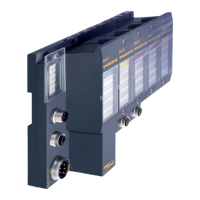Glossary
D300529 0115 - BL67 I/O modules16-4
Inactive metal components
Conductive components that cannot be touched and are electrically isolated from active metal components by
insulation, but can adopt voltage in the event of a fault.
Inductive coupling
Magnetic inductive couplings occur between two cables through which an electrical current is flowing. The
magnetic effect caused by the electrical currents induces an interference voltage. Typical sources of interference
are for example, transformers, motors, parallel-routed network and HF signal cables.
Intelligent modules
Intelligent modules are modules with an internal memory, able to transmit certain commands (e. g. substitute
values and others).
Load value
Predefined value for the counter module with which the count process begins.
Lightning protection
All measures taken to protect a system from damage due to overvoltages caused by lightning strike.
Low impedance connection
Connection with a low AC impedance.
LSB
Least Significant Bit
Mass
All interconnected inactive components that do not take on a dangerous touch potential in the case of a fault.
Master
Station in a bus system that controls the communication between the other stations.
Master/slave mode
Mode of operation in which a station acting as a master controls the communication between other stations in a
bus system.
Module bus
The module bus is the internal bus in a BL67 station. The BL67 modules communicate with the gateway via the
module bus which is independent of the fieldbus.
MSB
Most Significant Bit
Multi-master mode
Operating mode in which all stations in a system communicate with equal rights via the bus.
Namur
German acronym for an association concerned with standardizing measurement and control engineering. Namur
initiators are special versions of the two-wire initiators. Namur initiators are characterized by their high immunity
to interference and operating reliability, due to their special construction (low internal resistance, few
components and compact design).

